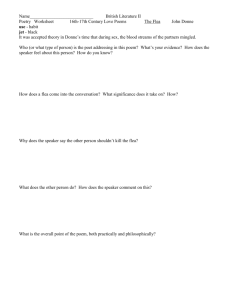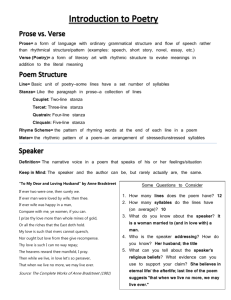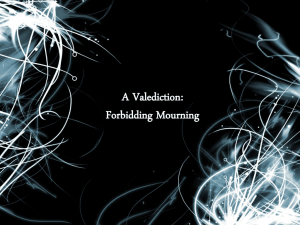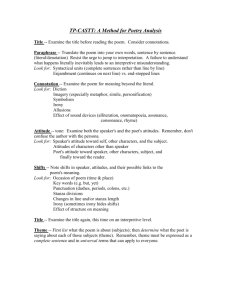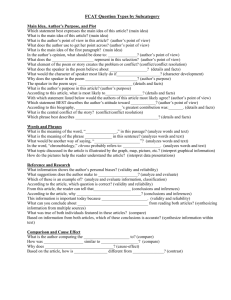Explication: Answer 1 “The Flea,” which is a classic metaphysical
advertisement
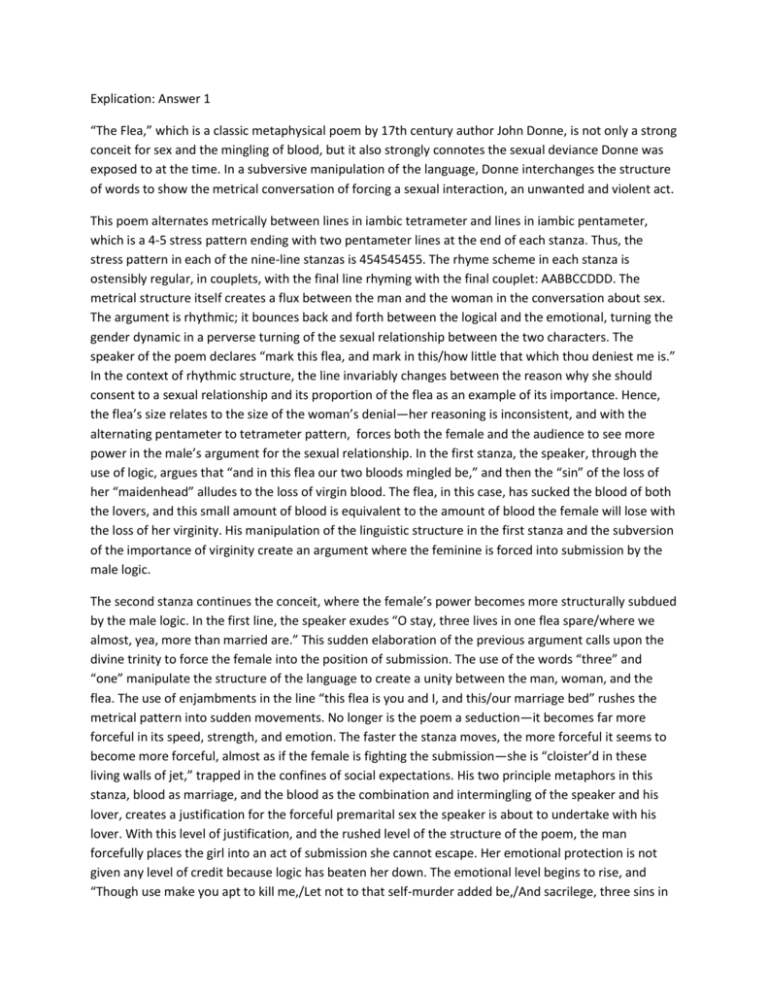
Explication: Answer 1 “The Flea,” which is a classic metaphysical poem by 17th century author John Donne, is not only a strong conceit for sex and the mingling of blood, but it also strongly connotes the sexual deviance Donne was exposed to at the time. In a subversive manipulation of the language, Donne interchanges the structure of words to show the metrical conversation of forcing a sexual interaction, an unwanted and violent act. This poem alternates metrically between lines in iambic tetrameter and lines in iambic pentameter, which is a 4-5 stress pattern ending with two pentameter lines at the end of each stanza. Thus, the stress pattern in each of the nine-line stanzas is 454545455. The rhyme scheme in each stanza is ostensibly regular, in couplets, with the final line rhyming with the final couplet: AABBCCDDD. The metrical structure itself creates a flux between the man and the woman in the conversation about sex. The argument is rhythmic; it bounces back and forth between the logical and the emotional, turning the gender dynamic in a perverse turning of the sexual relationship between the two characters. The speaker of the poem declares “mark this flea, and mark in this/how little that which thou deniest me is.” In the context of rhythmic structure, the line invariably changes between the reason why she should consent to a sexual relationship and its proportion of the flea as an example of its importance. Hence, the flea’s size relates to the size of the woman’s denial—her reasoning is inconsistent, and with the alternating pentameter to tetrameter pattern, forces both the female and the audience to see more power in the male’s argument for the sexual relationship. In the first stanza, the speaker, through the use of logic, argues that “and in this flea our two bloods mingled be,” and then the “sin” of the loss of her “maidenhead” alludes to the loss of virgin blood. The flea, in this case, has sucked the blood of both the lovers, and this small amount of blood is equivalent to the amount of blood the female will lose with the loss of her virginity. His manipulation of the linguistic structure in the first stanza and the subversion of the importance of virginity create an argument where the feminine is forced into submission by the male logic. The second stanza continues the conceit, where the female’s power becomes more structurally subdued by the male logic. In the first line, the speaker exudes “O stay, three lives in one flea spare/where we almost, yea, more than married are.” This sudden elaboration of the previous argument calls upon the divine trinity to force the female into the position of submission. The use of the words “three” and “one” manipulate the structure of the language to create a unity between the man, woman, and the flea. The use of enjambments in the line “this flea is you and I, and this/our marriage bed” rushes the metrical pattern into sudden movements. No longer is the poem a seduction—it becomes far more forceful in its speed, strength, and emotion. The faster the stanza moves, the more forceful it seems to become more forceful, almost as if the female is fighting the submission—she is “cloister’d in these living walls of jet,” trapped in the confines of social expectations. His two principle metaphors in this stanza, blood as marriage, and the blood as the combination and intermingling of the speaker and his lover, creates a justification for the forceful premarital sex the speaker is about to undertake with his lover. With this level of justification, and the rushed level of the structure of the poem, the man forcefully places the girl into an act of submission she cannot escape. Her emotional protection is not given any level of credit because logic has beaten her down. The emotional level begins to rise, and “Though use make you apt to kill me,/Let not to that self-murder added be,/And sacrilege, three sins in killing three” illustrates a struggle. He demands her not to kill the flea, just as he commands her to deny her preconceived religious notions in favor of his argument, forcing her into a corner where she is unable to escape. The speaker furthers his rushed argument by demanding that the female lover should not have “purpled thy nail in blood of innocence,” which has two possible interpretations. It could be read as the female smashing the flea, or it could allude to the sexual struggle of forcing sex upon the female, where she could scratch him, resisting his advances. In the “drop which it suck’d from thee?” the elision of “suck’d” not only creates a higher rhythmic metrical pattern of the last stanza, but also references the blood that could have been taken from stripping the girl of her virginity. When the speaker says “yet thou triumph’st,” she may have fought him off. The speed of the meter slows down, and the speaker declares, “when thou yield’st to me,/will waste, as this flea’s death took life from thee.” The speaker discounts her hesitation and resistance of his sexual advances, by saying that her convictions of the consummation of their relationship are simply “fears” and the fears are completely disregarded because the blood has already been combined and thus destroyed with the death of the flea. The speaker is defeated with the enjambed last line “yield'st to me,/Will waste, as this flea's death took life from thee.” The use of the word “yield” is again a forceful connotation of the perverse action he has performed upon the girl. The flea’s living incarnation is now dead, just as his sexual encounter with the girl and its possibilities are also dead. Donne’s structure of “The Flea” is an extremely sensual poem, though with the structure and metrical flow, the poem emphasizes the violence and forceful relationship in the act of sex. Sex, in the context of the poem, is far from sensual and delicate—it is violent, obstructed, and painful. Therefore, the act the speaker wishes to perform with his lover is a rape, an overthrow of the will of God, the trinity, and the girl’s convictions. It can only be assumed that Donne’s violent imagery alludes to his own possible hesitation to violate religious law and emotional sanctity with the bodily violation sex offers—marital or otherwise. Answer 2: “The Flea” is a poem written by John Donne in the 16th century. This poem is a prime example of the kind of work done by what would later be called the metaphysical poets. Other poets of the time associated with this group include George Herbert, Richard Shaw, and Andrew Marvell among others. These poets were famous for surprising their readers with vivid imagery, a blending of secular and religious subjects, and, especially relevant to “The Flea,” conceits that establish a persuasive argument (poets.org). In this poem Donne explains away many of the conservative mores regarding love and its physical manifestation through a logical conceit that stays with the reader due to its opposition with the beauty normally associated with themes on love and faith. In so doing he not only creates a sound argument, but he also uses religious imagery to give the speaker’s mate little to no appeal to refuse whether through logic, religious conservatism, or family pressure. Donne is able to strengthen this argument through the form and content of the poem. To begin to appreciate all the nuances of this poem, however, it is first useful to begin with a literal approach to Donne’s argument. The first stanza establishes the foundation for his argument. The speaker comments to his would-be lover that a flea that bites her and then bites him represents the ease with which the two of them could have sex. During the time Donne wrote this poem sex was defined as a mixing of blood, so it follows that what the flea has done is analogous to their having sex. Donne writes, “And in this flea our two bloods mingled be” (ln 4). He argues that one can hardly call this sinful or shameful, yet it is the closest the speaker and his love have come to actually having sex. In the second stanza the speaker likens the flea to their marriage bed. The speaker also admits that there are obstacles in the way of their love such as their parents. The speaker warns the girl that killing the flea is like killing parts of all three of them—the speaker, his mate, and the flea. The third stanza represents the speaker’s most coercive argument. In it his mate kills the flea, which is evidenced by the speakers question, “…hast thou since/ Purpled thy nail in blood of innocence (ln 20)?” It is at this point that the reader hears anything from the woman at all, and this is only through the speaker’s explanation. She claims that killing the flea didn’t hurt either of them despite it having some part of both of them inside of it. The speaker uses this argument to fuel his last claim that if the killing of the flea does no damage to the two of them, then her consenting to have sex with him will not hurt them either. It is certainly possible that the speaker may be a woman and the mate a male, as there is no explicit evidence either way. The logic exhibited in this poem is fairly sound, but what make this poem especially compelling are the ways in which Donne crafted the form, the images he used, and the way in which he utilizes a logical conceit in matters of love, which is traditionally not based on logic. This poem is comprised of three stanzas of nine lines each. In this way the stanzas are similar to a Spenserian stanza, but there is no regular meter. Some criticized Donne’s poetry for this lack of metrical pattern. The first two stanzas both have shortened and offset lines at their ends. This is significant, as they represent a shift in the conversation. In the first stanza, the speaker states the logical conclusion to the lack of shame in the flea partaking on both of their bodies. The shift in the second stanza occurs between the defense that the flea is like a marriage bed and a plea not to kill the flea, as it is like killing all three of them. The third stanza also has a similar shift, and it is significant that the lines appear uniform despite the previous two stanzas. In this way the three stanzas appear as an equation of sorts. Variable A plus variable B equals the conclusion. The shortened lines give the first two a look on incompleteness, where the third looks like a tidy whole. The rhyme scheme also works to add a feeling of balance and unity to his argument. Most of the end rhyme is regular, and as it is read these rhymes work to tie the whole thing together. Lines rhyme like couplets and tercets, yet there is not a consistent rhyme pattern throughout the poem. Rhymes are interspersed throughout all three stanzas. For instance lines two and three rhyme with lines 16 through 18, 21 and 22, and lines 25 through 27. Not only do these lines rhyme, but they use the same words, “three,” be,” and “me.” This creates a logical unity in the poem tying the argument together. Not only is the form consistent with the logic present in the poem, but images Donne uses anticipates some of the possible arguments his mate may raise. From the poem, it does not appear that a lack of love for each other keeps these two apart. There is the issue of their parents not consenting to the match as evidenced in line 14, but what is really preventing this woman from consenting are the religious based values of the time. There is evidence for this in the first stanza, where the speaker mentions “A sin, nor shame, nor loss of maidenhead” (ln 6). This is at the heart of her resistance. Donne counters these concerns by including religious language in his argument. He refers to the potential killing of the flea as a “sacrilege” (ln 18), and in the same line he states “three sins in killing three,” which is a common reference to the Holy Trinity in Christianity. Another obvious allusion to Christianity is used when the woman kills the flea in the third stanza and the speaker refers to the flea’s blood as the “blood of innocence” (ln 20). The speaker uses these religious ideas in defense of his argument, which makes them appear to have more weight in the eyes of someone that is clearly concerned with religion. Of course, there is further evidence of this when the speaker refers to the flea as a “marriage bed, and marriage temple is” (ln 13). What is especially interesting about this argument, though, is the use of the conceit, where sex is compared with a flea. As mentioned above, a conceit comparing two unalike things is one of things metaphysical poets like Donne do well. In this poem Donne compares sex to a flea ingesting the blood of two people. By making his argument through this conceit he is able to distance the conversation from what is actually being discussed. The conclusion the speaker reaches at the end is a proxy for the conclusion that the two should consummate their relationship. Not only does this work for the argument, but it also captivates the reader’s attention. The way in which Donne uses a parasite as the subject of a love poem is jarring, and this juxtaposition of love, religion, and ugly violence (the killing of the flea) is what makes this poem memorable. In his poem, “The Flea,” Donne achieves several levels of success. He uses form to buttress the content of his poem, as the form works to represent the logical movements of the speaker’s arguments. He discredits the religious/moral objections the speaker’s mate or any reader may make by using religious images to describe the two’s union through the flea. He also picks a repulsive subject like a flea to discuss some of the most beautiful ideas poets tend to write about—love and faith. For these reasons it is easy to understand why we are still reading him almost 400 years after his death.
